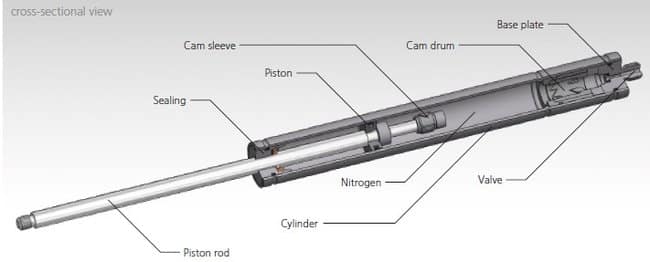Gas struts are an essential component of many pieces of equipment, machinery, and furniture, yet most people tend to overlook them. These small gas-filled cylinders are a type of mechanism that helps lift and support an object’s weight, with varying degrees of force and pressure. They have many applications in the construction industry, automotive industry, and even in our home interiors. But what are gas struts, exactly, and how do they work? In this article, we’ll take a closer look at these useful mechanisms and explore how they function.
What are the components?
Gas struts consist mainly of three basic parts: a piston, a cylinder, and a pressurized gas charge. When you apply force to the piston, the gas inside the cylinder pushes back against it, causing the piston to extend outward from the cylinder. This extension strengthens the gas strut, able to provide support through force. The greater the pressure within the cylinder, the more force the gas strut generates and applies, lifting and holding the weight.
What is the gas?
The gas used in struts is usually nitrogen, which has a very low reactiveness and can be safely pressurised. The pressure within the cylinder needs to be carefully balanced with the weight of the object being lifted, in order to ensure that the force applied is equal on both sides. Too much or too little pressure could cause an imbalance and may result in serious injury
The type of gas charge used also affects the strength and performance of gas struts. One of the most commonly used gases is nitrogen. Nitrogen gas is preferred for many applications because it is clean and inexpensive, which means lower operating costs and maintenance. Additionally, nitrogen is non-flammable and non-toxic, making it safer to use in a wide range of scenarios.
Are there different kinds of gas struts?
You can find a wide variety of gas strut designs, some of which have different mechanisms and features. For instance, the two main types of gas struts are standard gas struts and locking gas struts. Standard gas struts provide a single directional force, usually a lifting force, whereas locking gas struts provide a two-way directional force. This means that aside from lifting objects, they can also hold them at an angle, preventing them from slumping back down.
What size of gas strut do I need?
Gas struts also come in varying lengths and strengths. Naturally, longer gas struts provide more lift, but the strength of the lift also depends on the construction material of the strut’s cylinder. Additionally, designers can customize the strength of the gas strut by using a different amount of gas charge, meaning that you can adjust gas struts to fit the precise needs of a particular application.
Who uses gas struts?
Gas struts have several applications in the construction industry due to their strength, reliability, and ease of use. These applications include:
Lifting and holding heavy equipment
Supporting doors and windows
Lifting storage compartments
Opening and closing hatches
Supporting medical equipment
Lifting machinery and vehicles
Conclusion:
In conclusion, gas struts are an important and versatile tool used in many industries. They are a reliable, safe, and cost-effective solution for many applications, from lifting and holding heavy equipment, to supporting doors, hatches, and even medical equipment. We hope this brief overview has helped you better understand what gas struts are and how they function. If you are considering using gas struts in your next construction project, be sure to keep these factors in mind.
OpenUp® windows use non-locking, nitrogen-filled gas struts that are designed to be of only one length that has been engineered specifically to open the window up to the. 90˚ position. The strength of the gas strut has also been calculated based on the weight of the sash which increases as the area of the glass increases. Unlike other manufacturers of gas strut pass-through windows, OpenUp® covers even the gas strut with their 10-year warranty.


